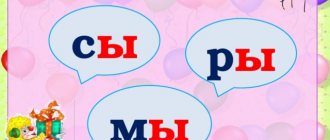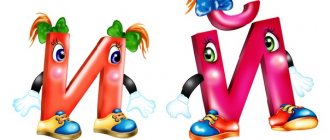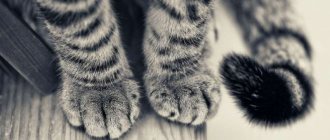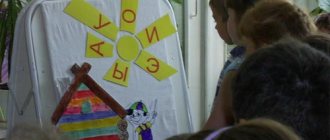Summary of educational activities for preparing for teaching literacy in the senior group on the topic “Sounds [a], [u]. Letters A, U"
author: Gantseva Marina Arkadyevna
Teacher-speech therapist Federal State Budgetary Preschool Educational Institution "Kindergarten No. 568", Yekaterinburg
Summary of educational activities for preparing for teaching literacy in the senior group on the topic “Sounds [a], [u]. Letters A, U"
Summary of educational activities for preparing for teaching literacy in the senior group
on the topic “Sounds [a], [u]. Letters A, U"
The summary was compiled by:
Gantseva M. A. (teacher-speech therapist)
Federal State Budgetary Educational Institution "Kindergarten No. 568", Yekaterinburg
Tasks:
- clarify the concept of “vowel sounds”;
- learn to differentiate the sounds [a], [u];
- learn to highlight the first sound in a word;
- learn to select words with a given initial sound using visual support and without it;
- develop phonemic hearing;
- develop skills in sound analysis and synthesis of syllables, reading syllables (ay, ua);
- fix the graphic image of the letters A, U;
- develop memory;
- cultivate curiosity, interest in sounds and letters;
- cultivate a caring attitude towards things (aids used in class).
Equipment:
- laptop, projector, speakers, presentation; cards for continuous reading of syllables (au, ua); magnetic board, red chips (magnets); letters A, U; pointer; diagram for determining the place of a sound in a word, red chip;
- for children: individual mirrors; diagrams for determining the place of a sound in a word; sound pencil cases (with chips in red, green and blue); notebooks; cards for continuous reading of syllables (au, ua); cash registers; simple pencils, counting sticks (letter set).
GCD move:
- Introductory part. Game "Memorize and repeat"
:
| watermelon – shark – orange pineapple – apricot – Africa album – stork – arch | morning - street - ear Ulya - mind - mustache already - knot - clever |
Articulation gymnastics
. “Window”, “Tube”, “Window - tube”, moving the lips with a “proboscis” to the right and left, “Horse”.
SLIDE No. 2
- Main part:
1) “Sounds [u], [a], we know you!”:
— What sounds did we study? (A, U) Let's remember about them, everything we know.
SLIDE No. 3
- How is Anya crying? (A)
SLIDE No. 4
- How does a wolf howl? (U)
SLIDE No. 5
- Now listen to me and guess who it is: Anya or the wolf? (The speech therapist pronounces the sounds [a], [u] several times, the children guess everything together and individually)
SLIDE No. 6
Clarification of the articulation of sounds [a], [u].
Children tell the snail about the articulation of the sound [u], and Aibolit - about the articulation of the sound [a].
The articulation analysis plan appears gradually in the presentation:
- lips
- teeth
- language
- how the air comes out of the mouth (freely) - a “breeze” flies out (picture)
Guessing sounds from silent articulation.
SLIDE No. 7
- What color are the sounds [a], [u]? In what color castle do the sounds [a], [u] live? (Children choose)
SLIDE No. 8
Characteristics of sounds (vowel sounds). Children tell Dunno.
- What is the sound? (Vowel) Why? (Air comes out of the mouth freely).
- What is the sound? (Vowel) Why? (Air also comes out of the mouth freely).
SLIDE No. 9
2) Game “Name the first sound in the word.”
The speech therapist and children take a diagram to determine the place of a sound in a word, put a red chip in the first window (the sound at the beginning of the word)
Pictures appear on the screen, children name them by highlighting the first sound and clicking on the chip. Children name the first sound (all together and individually).
Pictures: pineapple, stork, duck, bus, iron, fishing rod, shark, oranges, snail, duckling, apricot, street.
3) Didactic game “Guess the word” (based on pictures).
SLIDE No. 10
The speech therapist says: “I will make words. To guess a word, you will need to add the first sound to it - [a] or [y]. Pictures will help you guess the words.” Vocabulary material: ...pelsins, ...tyug, ...bus, ...tenok, ...bricot, ...fabric, ...litka, ...daughter, ...kula, ...faces, ...nanas, ...ist..
4) Physical exercise “A or U?”
The speech therapist pronounces the sounds [a], [u]. Children, if they hear the sound [a], pretend to be a stork; if they hear the sound [u], they pretend to be a Cheburashka with big ears.
SLIDE No. 11
— Guys, let's talk about the letter U.
SLIDE No. 12
5) Letter U.
- Showing a letter.
- Finding a letter in the cash register.
- “How many elements does the letter U have? What are these elements? What does this letter look like?
- Laying out letters from sticks.
- Game “Right - Wrong” (Children determine whether the letter U is written correctly)
SLIDE No. 13
- Drawing a letter in the air (On the screen there is a slide with animation - a snail is crawling, helping to correctly draw the letter U in the air).
SLIDE No. 14
- Game “Identify the sound U”. Children name the pictures that appear on the letter U, emphasizing the sound [u]. Perform finger exercises:
- “Fishing rod” - show the index finger of the right hand (the other fingers are clenched) and rotate the thumb of the left hand.
- “Snail” - first depict a snail with one hand (show the index and middle fingers - “horns”), move the hand along the table (“the snail is crawling”), then with the other hand.
- “Iron” - depict an iron (put one hand palm down on the table, the other hand on top, “iron”).
- “Duck” - show “beaks” with hands.
SLIDE No. 15
6) Game “Decorate the letter U”
. Children take turns naming words with the sound [y] at the beginning of the word. Each child says a word, and flowers appear on the screen (on the letter U).
SLIDE No. 16
— We remembered everything we know about the letter U. Now let's talk about the letter A.
Letter A - first letter a
alphabet (Children notice that the word “alphabet” begins with the sound [a].
7) Letter A.
- Showing a letter.
- Guys, find the letters A on this slide (the speech therapist calls one child to the board, he shows the letters with a pointer: A, a)
- “How many elements does the letter A have? What are these elements?
SLIDE No. 17
- Laying out letters from sticks.
SLIDE No. 18
- Finding a letter in the cash register.
- What does this letter look like?
SLIDE No. 19
- Drawing a letter in the air (On the screen there is a slide with animation - watermelons are moving, helping to correctly draw the letter A in the air).
SLIDE No. 20
 Game “Decorate the letter A”
Game “Decorate the letter A”
. Children take turns naming words with the sound [a] at the beginning of the word. Each child says a word, and flowers appear on the screen (on the letter A).
SLIDE No. 21
9)
Analysis and synthesis of the syllable AU.
The speech therapist shows a picture of Uli (Ulyana).
— Ulya went into the forest. There were a lot of mushrooms in the forest. While picking mushrooms, she went far into the forest and did not notice how she lost her way. Ole became scared. She remembered a short but very necessary word. If you shout, they will hear you and come to your aid. What word is this? (Aw!)
Children slowly pronounce the “word” AU in chorus and in rows.
- Name the first sound in the word Au (A). What is the sound? (vowel). It is indicated by a red chip (Children place the red chip on the table, and the speech therapist on the magnetic board).
- Name the second sound in the word Au (U). What is the sound? (vowel). Label it.
- The first sound is [a]. The second sound is [u]. What happened? (AU) Let’s “read” the word. I lead with a pointer, and you slowly sing each sound in the word (AU).
- Now let’s designate the sounds with letters. Let's read the word (using a card for continuous reading of the syllable AU).
SLIDE No. 22
10) Analysis and synthesis of the syllable UA
.
The speech therapist shows a picture of a crying child.
— The baby cries: “Wow!”
Children slowly pronounce the word UA in chorus and in rows.
The syllable UA is parsed similarly.
SLIDE No. 23
11) Typing syllables
AU, UA.
SLIDE No. 24 with the inscription “Well done!”
- The result of GCD. Reflection.
- Name words with the sound A. Name words with the sound U.
Summary of educational activities for preparing for teaching literacy in the senior group on the topic “Sounds [a], [u]. Letters A, U"
ECD for preparing children for learning to read and write “Journey to the country of Abvgdeyki”
- January 20, 2016
Competition “My Pedagogical Initiative - 2015”
Nomination “Methodological work in preschool educational institutions”
ECD for preparing children for learning to read and write (senior group) Topic: “Travel to the country of Abvgdeyki.”
Goal : to teach children sound analysis and synthesis of words.
Tasks:
- to form children’s knowledge of vowels and consonants;
- learn to determine the number of syllables in a word;
- learn to correlate sounds and letters;
- develop children's phonemic hearing and visual perception;
- develop children's speech;
- consolidate the ability to determine the presence of a given sound in a word;
- fix graphic images of letters;
- cultivate a desire to learn your native language.
Equipment : Demonstration material: “Locks for sounds”, manual “Herringbone”, magnetic board, flannelgraph with a silhouette of a tree, figures of animals and birds, toys, ball. Handout: pictures with images: bow and hatch, colored squares to indicate sounds in the word scheme, emoticons: sad and happy.
Vocabulary: hatch, crawl, breaststroke.
Progress of the lesson
Educator: Today our group received a letter from the Wise Owl. She invites us to the fairyland “ABVGDEIKU”. Want to? To get to this country we need to cross a magic bridge, but let’s first check if we can take you all there. I will throw the ball to you, and you will catch it, and answer my question; whoever answers correctly will be able to cross the magic bridge.
Ball game. “Catch the ball if you hear the sound r in the word” (sound a, sound k).
Educator: Well done, you all completed the task, which means you can all cross the bridge and get into the land of sounds. (Everyone goes through the bridge).
Educator: In this country of sounds there are two castles, sounds live in them. Look carefully and tell me, do they look alike? What is the difference? What sounds live in the red castle? What sounds live in the blue-green castle? Why is the second castle blue-green? Why is the door to the red castle open? Why is the door to the blue-green castle closed? Well done.
Educator: What else can you build castles from? I will name the material, and the one to whom I throw the ball will name what it will be: 1. - made of straw? – straw; 2. - made of stone? – stone 3. – made of wood? – wooden 4. – glass? – glass 5. – iron? – iron 6. – made of rubber? – rubber 7. – plastic? – plastic 8. – made of brick? – brick.
Articulation gymnastics.
Educator: Now let's try to build a house using our tongue. First, we put up the walls (fence). We will make large, bright windows (windows) in the wall. We will put shutters (sail) on the windows. We’ll build a pipe on the roof (pull your lips into a tube) And now we’ll paint the ceiling, windows (delicious jam, wash the floors (brush your teeth). Our house is ready, you can prepare for the holiday.
Game “Decorate the Christmas tree”.
Educator: What holiday is approaching? How do we celebrate it? (We decorate the Christmas tree). We also have a Christmas tree, but it is not decorated. I suggest decorating our Christmas tree with balls. But these balls are not simple, they have pictures on them. So, having received the ball, you must determine how many syllables are in the name of this picture. If there is one syllable, hang the ball on the topmost triangle, if two syllables - on the second middle triangle, if three syllables - on the largest bottom triangle. (Children check how many syllables are in the names of their pictures and, commenting, hang the balls on the Christmas tree). What a beautiful elegant Christmas tree we have!
Mapping words.
Educator: You and I have worked hard, decorated the Christmas tree, and now sit down at the tables and listen to the riddles of the Wise Owl, and we must compile the answers in the form of a diagram, we will find out what sounds live in these words. They threw off the golden feathers from Yegorushka, Made Yegorushka cry without grief. (Onion) Place a picture of an onion in front of you. How many sounds do you think there are in this word? Why?
There are three boxes under the picture, which means there are three sounds in the word. Look and listen to how to read this word and how the pointer will help me. Now let's try to read it the same way. Listen to how the first sound of Llluk sounds in the word. Repeat the word, emphasizing the first sound. What is he like? (l-consonant, hard, indicated in blue). Listen to what the second sound sounds like -Luuuk, repeat what sound it is (vowel, in red) Guess what the third sound sounds like in the word -LuUK, what is it? (consonant, hard, blue). What word will you get if you replace the letter y in the word onion with the letter y? (Luke).
Take the picture of the hatch. (We perform the same analysis of the word with the word hatch.)
Educator: Now let's play the game "Live Sounds" . Those children who guess my riddles will play. What is the second sound in the word “bow”, what is the first sound, what is the third sound? Now make up a word. Did the children form the word correctly? The sound “K” - name a word based on your sound, the sound “L” - name your brother, the sound “U” - spin around in place. Well done, sounds, you completed the tasks. Put sounds in your houses and sit down.
Articulation game “Guess what vowel sound I will pronounce?” The teacher, without a voice, “pronounces” vowel sounds with his lips alone. The child must guess, then the children “guess” their vowel sounds.
Educator: I suggest you go further. Look, a tree has grown on our way, and little animals are sitting under the tree and don’t know what to do? Let's help them find their places. - Place on the top of the tree a bird whose name begins with the sound [s] (magpie) - Place on the trunk of a tree an animal whose name begins with the sound [b] (squirrel) - Under the tree on the right, plant a bird whose name begins with [y] (duck) - Plant under a tree an animal whose name begins with the sound [k] (cat) - An insect flies above the cat, whose name begins with the sound [o] (wasp) Well done.
We helped all the animals find their places and can return to kindergarten. The owl says thank you and gives you toys. You need to select only those objects whose names contain the sound k (cube, boat, book, pencil, pen, dog, bag, snowflake, butterfly, cat, frog, paint).
It’s time for us to return to the group, but look, our bridge has disappeared somewhere, probably washed away by water. How can we cross to the other side? (Children express opinions). Yes, you can swim across the river. We quickly went down to the river, bent down, washed ourselves, 1, 2, 3, 4 - that’s how nicely we refreshed ourselves. And now we swam together, You need to do this with your hands: Together once is breaststroke, One and the other is crawl, we all swam as one, We look like dolphins. So we swam across the river.
Bottom line.
Educator: Where have we been? What interesting things did you see or learn in the fairyland, what did you like most? The Wise Owl handed me the chest. Let's see what lies there? These are emoticons, look how different they are. There is a happy smiley and a sad one. I suggest you choose your own emoticons. If you liked our trip, it was easy for you to complete the tasks, take a cheerful emoticon, and if you were bored, it was not very easy to complete the tasks - a sad one.
Author: Nishcheva Vera Nikolaevna, teacher at MBDOU kindergarten No. 69 “Malvina”, Tambov.







